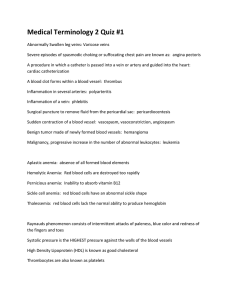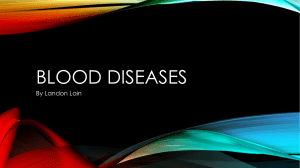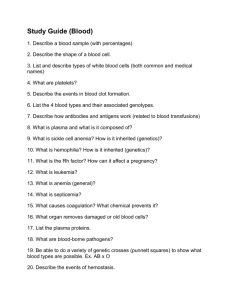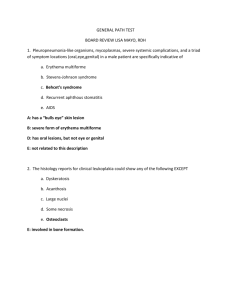Factors affecting erythropoiesis
advertisement
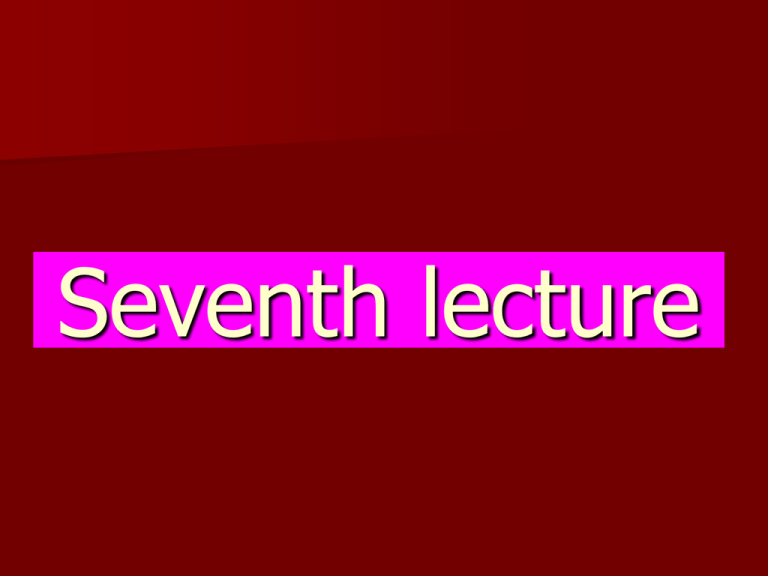
Seventh lecture Hematopoiesis Factors affecting erythropoiesis:A)-Oxygen supply of tissues: Decreased oxygen supply (hypoxia) to tissues stimulates secretion of erythropoietin (EP) hormone. Hypoxia stimulates kidney to release renal erythropoietic factor (REF). Hypoxia stimulates liver to produce a special type of globulin. Both REF & globulin unite in plasma and form EP. EP then stimulates bone marrow to produce RBCs. Erythropoietin accelerates nearly all stages of RBCs formation, i.e. it stimulates proliferation & differentiation of progenitor stem cells to produce mature RBCs. Hematopoiesis Factors affecting erythropoiesis:B) Dietary factors: i-Proteins: Proteins of high biological value are needed in the formation of RBCs. ii-Metal ions: Iron Fe: is essential for RBCs formation because it enters in the formation of the hem part. Copper Cu: It is carried & transported by plasma protein ceruloplasmin. It catalyses the oxidation of Fe++ to Fe+++, a reaction that must occur before transferrin can combine and transport iron. Cobalt Co: It stimulates EP release from kidney. So, excess Co may produce polycythaemia. Hematopoiesis Factors affecting erythropoiesis:B) Dietary factors: iii-Vitamins: Both vitamins B12 & folic acid are essential for final maturation of RBCs because they are needed in DNA synthesis. Deficiency of either B12 or folic acid results in failure of nuclear maturation and causing maturation failure anemia. Vitamin C is a strong reducing agent which is important in reducing the ferric form of iron to ferrous to facilitate its absorption and transport. Hematopoiesis Factors affecting erythropoiesis:C) Hormonal factors: i-Androgens: increase erythropoiesis by stimulating the production of erythropoietin from kidney. ii-Thyroid hormones: Stimulate the metabolism of all body cells including the bone marrow cells, thus, increasing erythropoiesis. Hypothyroidism is associated with anemia while hyperthyroidism is associated with polycythaemia. Hematopoiesis Factors affecting erythropoiesis:C) Hormonal factors: iii-Glucocorticoids: Stimulate the general metabolism and also stimulate the bone marrow to produce more RBCs. In Addison’s disease (hypofunction of adrenal cortex) anemia present, while in Cushing’s disease (hyperfunction of adrenal cortex) polycythaemia present. Hematopoiesis Factors affecting erythropoiesis:C) Hormonal factors: iv-Pituitary gland: Affects erythropoiesis both directly and indirectly through the action of several hormones. v- Haematopoietic growth factors: Are secreted by lymphocytes, monocytes & macrophages to regulate the proliferation and differentiation of proginator stem cells to produce blood cells. Hematopoiesis Factors affecting erythropoiesis:D)-State of liver & bone marrow: i-Liver: Healthy liver is essential for normal erythropoiesis because the liver is the main site for storage of vitamin B12 , folic acid, iron & copper. In chronic liver disease anemia occurs. ii-Bone marrow: When bone marrow is destroyed by ionizing irradiation or drugs, aplastic anemia occurs. Anemia Anemia means a decrease in hemoglobin content, or RBCs count, or both of them below the normal range. Anemia leads to a decrease in blood ability to transport oxygen to tissue cells. Anemia Types & causes of anemia: I-Blood loss anemia: A-Acute blood loss anemia: Due to severe hemorrhage. Plasma volume is replaced rapidly by the fluids present in tissue spaces. This leads to marked dilution of the blood. RBCs are replaced within 2-3 weeks. Sufficient iron gives normocytic cells but insufficient iron will produce microcytic RBCs. Anemia Types & causes of anemia: I-Blood loss anemia: B-Chronic blood loss anemia: Due to repeated loss of small amounts of blood over a long period e.g.: -Gastrointestinal bleeding (peptic ulcer) -Excessive menstruation. -Hemorrhagic diseases. Due to depletion in iron stores the newly formed RBCS are microcytic. Anemia Types & causes of anemia: II-Aplastic anemia: It results from destructione of bone marrow. It may result from: 1-Excessive exposure to x-rays or gamma rays. 2-Chemical toxins e.g. cancer therapy & prolonged exposure to insecticides or benzene. 3-Invasion of bone marrow by cancer cells. 4-Following infection by hepatitis. Damaged bone marrow don’t produce any RBCs, so in aplastic anemia RBCS are normocytic. It is associated with decrease in WBCs & platelets. Anemia Types & causes of anemia: III-Hemolytic anemia: It results from increased rate of destruction of RBCs inside the cardiovascular system. Causes of hemolytic anemia: A-Hereditary: 1-Membrane abnormalities. 2-Enzyme deficiency e.g. G-6-P Dehydrogenase. 3-Hemoglobin abnormalities. B-Acquired: 1-Incompatible blood transfusion. 2-Parasitic infection e.g. malaria. 3-Toxic agents e.g. snake venom & insect poisons. 4-Thermal e.g. several burns. Anemia Types & causes of anemia: IV-Dyshemopoietic anemia: Which may be due to: 1-Iron deficiency anemia. 2-Maturation failure (megaloblastic) anemia:a-Vitamin B12 deficiency. b-Folic acid deficiency. 3-Anemia of endocrine disorders. 4-Nutritional anemia. 5-Anemia of renal failure. Polycythemia It is an abnormal increase in the number of circulation RBCs. A-Primary polycythemia: It is caused by tumor of bone marrow. B-Secondary polycythemia: It occurs as a result of prolonged tissue hypoxia. II-Respiration Respiratory system Respiration serves the following functions Supplies tissues with O2 Eliminate CO2 from tissues. Regulates the pH of the blood. Maintain normal body temperature Respiration I- External Respiration: Exchange of respiratory gases between air in lungs and blood in pulmonary capillaries. Respiration II-Internal Respiration: Exchange of respiratory gases between the tissue cells and the internal environment which is the fluids bathing the cells. Oxidation of food stuffs within cells to yield energy (in presence of oxygen). The respiratory system is divided into two zones: I- The Conducting Zone II -Respiratory Zone I- The Conducting Zone: Includes : nose, nasopharynx, larynx, trachea and 2 main bronchi one for each lung, and smaller bronchioles . Function of the conducting part: 1. Conducting air into the respiratory zone. 2. Air conditioning 3. Humidification 4. Filtration 5. Protective reflexes a- Sneezing reflex b- Cough reflex 6. Non respiratory function. II -Respiratory Zone: Consists of respiratory units each of which composed of respiratory bronchioles which subdivided into alveolar ducts which end in clusters of small thin walled air sacs called alveoli Functions of Respiratory Passages 1-The nose a) The vestibule. b) The respiratory area. c) The olfactory area. The olfactory area is lined by olfactory mucosa which consists of: (A) Olfactory epithelium consists of three types of cells: 1- Sustentecular (supporting) columnar cells 2- Olfactory (sensory) cells 3- Basal cells (B) Corium 2- Pharynx The pharynx is the part of the digestive system of many animals lies immediately behind the mouth and in front of the esophagus The human pharynx is divided into: • Nasopharynx. • Oropharynx. • Laryngopharynx. 3- The Larynx The larynx has the following functions: 1- Control of the airflow during breathing. 2- Protection of the airway. 3- Production of sound for speech.
